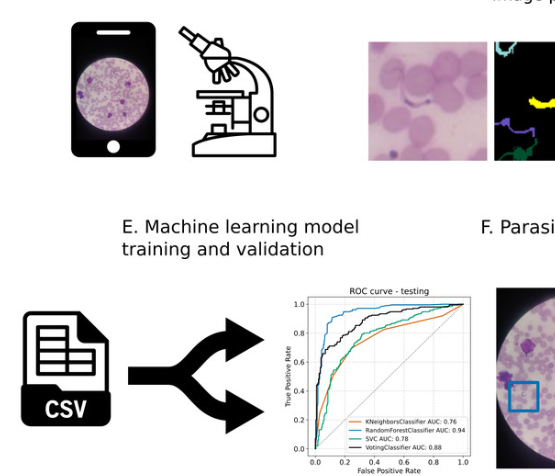Automatic detection of the parasite Trypanosoma cruzi in blood smears using a machine learning approach applied to mobile phone images
Chagas disease is a life-threatening illness caused by the parasite Trypanosoma cruzi. The diagnosis of the acute form of the disease is performed by trained microscopists who detect parasites in blood smear samples. Since this method requires a dedicated high-resolution camera system attached to the microscope, the diagnostic method is more expensive and often prohibitive for low-income settings. Here, we present a machine learning approach based on a random forest (RF) algorithm for the detection and counting of T. cruzi trypomastigotes in mobile phone images. We analyzed micrographs of blood smear samples that were acquired using a mobile device camera capable of capturing images in a resolution of 12 megapixels. We extracted a set of features that describe morphometric parameters (geometry and curvature), as well as color, and texture measurements of 1,314 parasites. The features were divided into train and test sets (4:1) and classified using the RF algorithm. The values of precision, sensitivity, and area under the receiver operating characteristic (ROC) curve of the proposed method were 87.6%, 90.5%, and 0.942, respectively. Automating image analysis acquired with a mobile device is a viable alternative for reducing costs and gaining efficiency in the use of the optical microscope.
Authors
Morais, Mauro Cesar Cafundo; Silva, Diogo; Milagre, Matheus Marques; de Oliveira, Maykon Tavares; Pereira, Thais; Silva, Joi£o Santana; Costa, Luciano da F; Minoprio, Paola; Junior, Roberto Marcondes Cesar; Gazzinelli, Ricardo;
External link
Publication Year
Publication Journal
Associeted Project
User-friendly computational Tools
Lista de serviços
-
Gene regulatory and signaling networks exhibit distinct topological distributions of motifs.Gene regulatory and signaling networks exhibit distinct topological distributions of motifs.
-
Gene signatures of autopsy lungs from obese patients with COVID-19.Gene signatures of autopsy lungs from obese patients with COVID-19.
-
Network Medicine: Methods and ApplicationsNetwork Medicine: Methods and Applications
-
ACE2 Expression Is Increased in the Lungs of Patients With Comorbidities Associated With Severe COVID-19.ACE2 Expression Is Increased in the Lungs of Patients With Comorbidities Associated With Severe COVID-19.
-
Drug repositioning for psychiatric and neurological disorders through a network medicine approach.Drug repositioning for psychiatric and neurological disorders through a network medicine approach.
-
Linking proteomic alterations in schizophrenia hippocampus to NMDAr hypofunction in human neurons and oligodendrocytes.Linking proteomic alterations in schizophrenia hippocampus to NMDAr hypofunction in human neurons and oligodendrocytes.
-
In-depth analysis of laboratory parameters reveals the interplay between sex, age, and systemic inflammation in individuals with COVID-19.In-depth analysis of laboratory parameters reveals the interplay between sex, age, and systemic inflammation in individuals with COVID-19.
-
The evolution of knowledge on genes associated with human diseasesThe evolution of knowledge on genes associated with human diseases
-
Network vaccinology.Network vaccinology.
-
Pyruvate kinase M2 mediates IL-17 signaling in keratinocytes driving psoriatic skin inflammationPyruvate kinase M2 mediates IL-17 signaling in keratinocytes driving psoriatic skin inflammation
-
Transcriptome analysis of six tissues obtained post-mortem from sepsis patientsTranscriptome analysis of six tissues obtained post-mortem from sepsis patients
-
Gene Signatures of Symptomatic and Asymptomatic Clinical-Immunological Profiles of Human Infection by Leishmania (L.) chagasi in Amazonian BrazilGene Signatures of Symptomatic and Asymptomatic Clinical-Immunological Profiles of Human Infection by Leishmania (L.) chagasi in Amazonian Brazil
-
In vitro morphological profiling of T cells predicts clinical response to natalizumab therapy in patients with multiple sclerosis.In vitro morphological profiling of T cells predicts clinical response to natalizumab therapy in patients with multiple sclerosis.
-
Integrative immunology identified interferome signatures in uveitis and systemic disease-associated uveitis.Integrative immunology identified interferome signatures in uveitis and systemic disease-associated uveitis.
-
Gene regulatory networks analysis for the discovery of prognostic genes in gliomas.Gene regulatory networks analysis for the discovery of prognostic genes in gliomas.
-
Revealing shared molecular drivers of brain metastases from distinct primary tumors.Revealing shared molecular drivers of brain metastases from distinct primary tumors.

